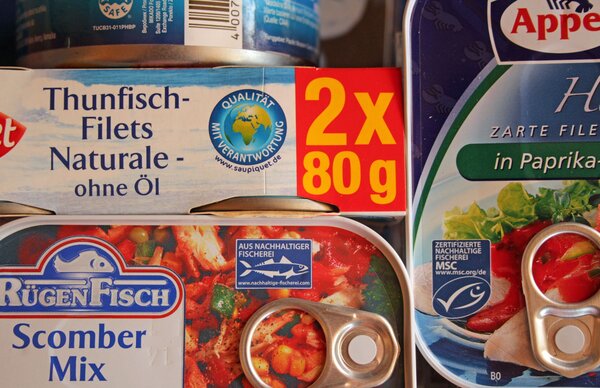Expertise
Sustainability certification of fisheries products: Are all eco-labels on the same quality level?
Christian von Dorrien, Christopher Zimmermann | 23.08.2022
Anyone who values sustainably caught fish when shopping has to look very carefully: There are now a large number of sustainability seals - with great differences in claim and credibility. The GSSI seal check can provide orientation here.
Fishery products whose catch or production is supposedly hardly harmful to the environment are increasingly being identified by sustainability seals. The number of these so-called seals has now risen to over 80.
What is the problem?
Unlike "organic" goods, there are no uniform requirements for sustainability standards in the EU. However, shortly after the founding of the Marine Stewardship Council (MSC), the Food and Agriculture Organisation (FAO) developed minimum criteria for ecolabels for fishery products.
In recent years, the number of fish labels has increased considerably. While most standards refer to the FAO minimum criteria, they fail to prove that they actually meet these criteria in full.
There are indications that, despite the considerable criticism of the MSC standard, there is not yet a single more demanding label on the market, but that the competitors make it easier for fisheries in particular to be certified - because the criteria are less strict or the certification is so simplified that it can be carried out more cheaply.
However, weaker criteria generally mean less credibility. The trade in particular therefore fears confusion among consumers and a devaluation of sustainability certification, which is a successful instrument in itself.
The different seals can of course set different priorities and choose different assessment approaches. While the MSC programme is globally applicable and does not include blanket bans on certain methods, others only examine bycatch of a certain group of animals and do not even consider the condition of the target stock (e.g. Dolphin SAFE). In others, only small farms are certified and the focus is on the income of the fishery (Naturland Wildfisch), for which the verification of ecological sustainability criteria is at least questionable.
Furthermore, it happens that there are blanket specifications for the amount of unwanted bycatch, even if it is higher than the usual bycatch in certain fisheries. For example, in the Friend of the Sea standard, bycatch rates of a flat eight percent of the weight of a total catch are acceptable, even though many fisheries already have bycatch rates averaging only two percent. As a result, fisheries with good fishing practices and two percent bycatch do not gain a competitive advantage over competitors with poor fishing practices and eight percent bycatch.
Still other labels are only regionally applicable, for example seals from Alaska and Iceland. Finally, there are also labels that only certify the origin and are not actually sustainability standards.
The solution: the GSSI "Seal Check”
In order to create clarity about the quality of the seals, trade, producers and processors at the international level have developed a tool for comparing different fish seals together with the Deutsche Gesellschaft für Internationale Zusammenarbeit (GIZ): The Global Sustainable Seafood Initiative (GSSI) uses a "seal check", the so-called Benchmark Tool, to assess whether the tested seal is credible and whether it meets the FAO's minimum requirements for sustainability standards.
The assessment with the Benchmark Tool has been taking place since 2017. By mid-2021, GSSI has recognised five seals for products from wild-caught marine fish. They are:
- the Alaska Responsible Fisheries Management (AKRFM) programme,
- the Iceland Responsible Fisheries Management (IRFM) programme,
- the Marine Stewardship Council (MSC)
- the Audubon Gulf United for Lasting Fisheries (G.U.L.F.) and
- the Marine Eco-Label Japan (MEL) version 2 (V2).
The verification (benchmarking) is - just like the certifications of the wild fisheries - voluntary: no standard is forced to participate. But most major European retailers have agreed not to accept any seals in the future that have not been successfully verified by the GSSI. The inspection criteria have been revised since 2019 in an elaborate process involving the interested public, adopted at the end of 2020 and have been in force since autumn 2021.
Thanks to the seal check by the GSSI, producers, processing companies and trade can opt for credible seals and thus consolidate consumer confidence in certified fishery products. In addition, the assessment by the GSSI creates incentives for already established seals to improve further.


![[Translate to English:] Logo des Bundesministerium für Ernährung und Landwirtschaft](/media/allgemein/logos/BMEL_Logo.svg)